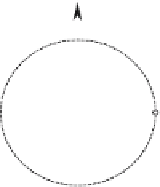Graphics Reference
In-Depth Information
7.3.4 Graphical interpretation of complex numbers
In 1806 Jean Robert Argand [1768-1822] showed that complex numbers had a useful geometrical
interpretation and could represent points in
2
. The breakthrough was to represent a complex
number as the coordinates of a point. But instead of using x-and y-axes, we employ real and
imaginary axes, as shown in Fig. 7.3.
R
imaginary axis
i
a
z
=
a
+
b
i
z
b
real axis
Figure 7.3.
7.3.5 i as a rotator
Once there was a geometric interpretation for complex numbers, it must have been tempting to
investigate the geometric impact arithmetic operations would have upon them. So let's explore
the geometric effect of repeatedly multiplying a complex number by
i
.
If the starting number is z
a, i.e., no imaginary component, then by multiplying z by
i
gives us a
i
. Multiplying again by
i
, we obtain
=
a
i
and a, respectively. The four multiplications have effectively rotated the complex number 360
,
as shown in Fig. 7.4.
−
a. The next two multiplications produce
−
i
a
i
-a
a
r
-
a
i
Figure 7.4.
This rotational ability applies to any complex number. For example, if the starting complex
number is 2
+
i
, and we repeatedly multiply by
i
, we obtain
−
1
+
2
i
−
2
−
i
1
−
2
i
2
+
i
whose positions are shown in Fig. 7.5.

















